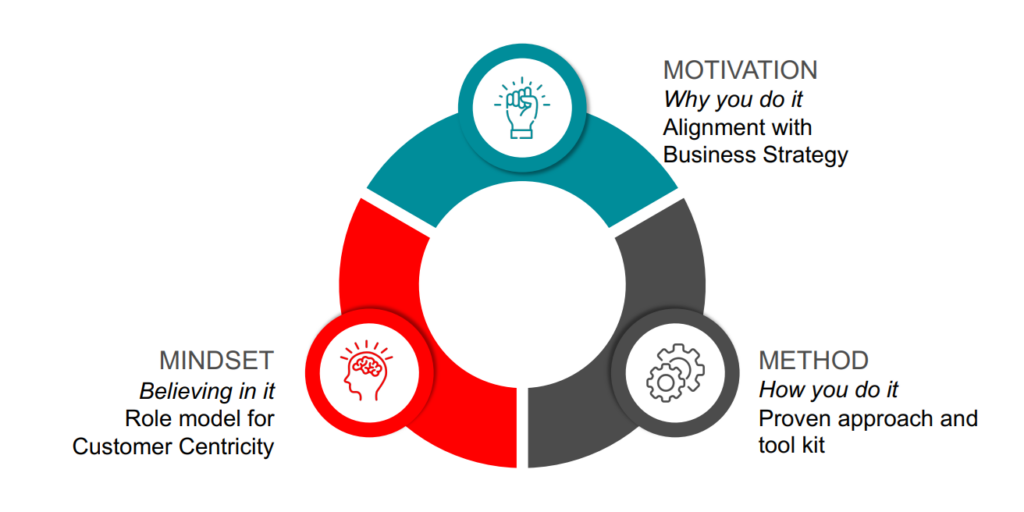Practical approaches to integrate CX practices into L&D and elevate learner engagement and satisfaction.
In Part 1, we explored the foundational ideas of CX in L&D. Now, let’s dive into practical strategies to implement these principles and elevate your learning and development initiatives.
The Three M’s Framework: Motivation, Mindset, and Methodology

The Three M’s – Motivation, Mindset, and Methodology – are essential to creating impactful L&D programmes.
1) Motivation
Every learning journey starts with motivation. Create a learning environment that inspires curiosity and commitment by clearly connecting training objectives with real-world benefits for learners.
Action Tip: At the beginning of each training session, outline the skills or knowledge learners will gain and how it directly impacts their roles. This sets the stage for active participation and internal motivation.
2) Mindset
Encouraging a learner-centric mindset across the organisation promotes a culture that values development. This involves shifting perspectives – seeing training not as an obligation but as an opportunity for growth.
Action Tip: Foster a growth mindset by celebrating small milestones along the learning journey and providing positive reinforcement, which can boost morale and increase long-term engagement.
3) Methodology
The approach to structuring and delivering learning is essential. Incorporate CX strategies, such as journey mapping and feedback loops, to ensure content is relevant, engaging, and continuously improving.
Action Tip: Use learner journey mapping to spot high-impact touchpoints and create targeted support resources. Regularly evaluate content and adjust based on learner feedback to keep the training fresh and aligned with their evolving needs.
Steps to Implement Voice of the Learner (VoL):
Gathering feedback is a fundamental CX strategy, and Voice of the Customer (VoC) methodologies are easily adapted to Voice of the Learner (VoL). By incorporating VoL, you create a channel for learners to voice their needs and challenges, providing insights that can shape and refine your programmes.
- Collect feedback: Use surveys, check-ins, or focus groups to understand learner experiences.
- Analyse insights: Identify patterns to refine programmes and remove obstacles.
- Close the loop: Act on feedback and communicate changes to show learners their input matters.
Personalisation vs Standardisation: Striking the Right Balance
Personalisation in learning enhances relevance and engagement, but excessive customization can lead to complexity without added value, as discussed in “Is Personalisation Overrated?“
- Adaptable modules: Create flexible core content learners can tailor to their needs.
- Optional tracks: Allow specialisation within standard curricula to boost relevance.
- Peer learning: Encourage knowledge sharing through group discussions and mentoring.
CX Metrics adapted to L&D
Adapting CX metrics helps measure learner engagement and satisfaction. NPS and CSAT are valuable metrics in Customer Experience for assessing customer happiness and effective learning engagement. These can be adapted:
- Learner Satisfaction Score (LSS): Ask learners to rate their overall course satisfaction.
- Net Promoter Score for Learning (NPS-L): “How likely are you to recommend this training to a colleague?”
- Root cause analysis: Address low-scoring areas to improve future sessions.
Practical Steps to Build a Learner-Centric Culture
Creating a learner-centric culture means making continuous improvements in response to learner needs and insights. In a learner-centric environment, training isn’t seen as a one-off event but as a core component of personal and professional growth within the organisation.
Leadership buy-in: Secure leaders’ support for learning as a priority.
Continuous iteration: Use regular feedback to refine training programmes.
Success stories: Share examples of training outcomes to inspire and motivate learners.
Conclusion: implementing CX practices in L&D
By implementing CX practices in L&D, organisations can transform training into a valuable, engaging, and continuous journey. By focusing on Motivation, Mindset, and Methodology, and using tools like VoL and CX metrics, you can build a learner-centric environment that drives success.
What CX strategies will you adopt in your L&D programmes?
Learn more about Lexden’s CX training offer.
To explore more ideas and connect with like-minded professionals, join the Customer Experience L&D Group. Share insights, discuss best practices, and help shape the future of CX and L&D.


